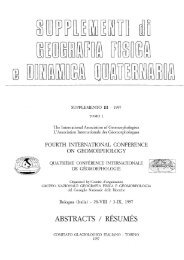Full Text (PDF)
Full Text (PDF)
Full Text (PDF)
Create successful ePaper yourself
Turn your PDF publications into a flip-book with our unique Google optimized e-Paper software.
FIG. 9 - North-eastern zone of the town of Bevagna: showing the semicircular<br />
structure of the Roman theatre (2nd Century BC). The straight road<br />
(black) in the bottom right corresponds to the Via Flaminia which<br />
crossed the town (from Google-Earth, modified).<br />
1st Century BC is still used for summer performances. In<br />
Spello there are ruins of a Roman theatre dating from the<br />
1st Century BC. Almost all the towns in this region have<br />
Roman walls, often with monumental gates, on which the<br />
medieval walls were built.<br />
Close to Mevania there was a harbour (fig. 10), which<br />
was the main port for shipping the products of the valley<br />
to Rome and was certainly an important economic struc-<br />
114<br />
ture (Cruciani, personal communication). In most towns<br />
there were also aquaeductus and termae, supplied by the<br />
abundant water in the Valley (Stefanucci, 2002).<br />
The above mentioned data document an extremely developed<br />
anthropization along the Valle Umbra and in most<br />
surrounding areas. The descriptions left us by a number of<br />
Roman authors (Plinius Iunior, 97-112; Propertius, 28-25<br />
BC; Silius Italicus, 92) celebrate the pleasant amenities of<br />
the area, and the account of military manoeuvres near Bevagna<br />
(Tacitus, 104) point to a highly advanced economy<br />
and vivacious activity, even though there were battles and<br />
fights between the Romans and local populations who attempted<br />
to retain their autonomy.<br />
All this points to a very positive morphological condition,<br />
both through control by human activity, and also<br />
because of the dry and warm climate which limited<br />
swamping and flooding, and eased the work of land reclamation<br />
(Desplanques, 1969).<br />
EARLY MEDIEVAL PERIOD: THE DECLINE OF<br />
ROMAN EMPIRE AND THE BARBARIAN INVASIONS<br />
Towards the end of the 3rd Century AD, the Roman<br />
Empire slowly declined. The centre of the Byzantine Empire<br />
came into conflict with Rome; Barbarian incursions,<br />
followed by invasions, contributed to the political disintegration<br />
of central Italy. Since the Valle Umbra was on an<br />
important communication route it was often traversed by<br />
armies and a theatre of battles (Albertini, 1966).<br />
This political situation coincided with a worsening of<br />
the climate: it became cold and rainy, and, the increase of<br />
FIG. 10 - Hypothetical reconstruction of Mevania harbour at the confluence of the Clitumnus and Tinea rivers. Legend: A) Via Flaminia, B) harbour,<br />
C) dock, E) Mevania Forum, G) and H) Temples, F) the cross-roads between Decumanus and Castrum. The thick black line indicates the perimeterwall<br />
of the Roman town. To the right an enlargement of the harbour zone: the Roman wall had two discontinuities which may represent the harbour<br />
mouths (drawn by W. Cruciani).















